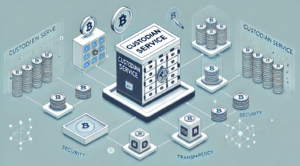
The Custody Innovation of Blockchain: A Game-Changer in Asset Management
November 1, 2024
Blockchain technology has introduced a revolutionary element to asset management: custody innovation. To understand the significance of this advancement, it’s essential to trace how we’ve managed records and ownership through history.
In the earliest societies, we lived in a world without formal registration systems. Transactions took place as bartering, where individuals exchanged commodities directly for other goods of perceived equal value. This simplicity in trade, while effective, was limited in scope and scale. As societies evolved, so did the need to formalize ownership and establish clear records. We began to record assets and commodities on paper, a change that enabled more efficient transactions but also added complexity. A paper-based system required verification, authorization, and storage, gradually creating a web of bureaucracy around each trade.
The advent of computers further transformed the world of asset management. With digital databases, we could store records more efficiently than with paper. However, true registration often remained tied to physical paper records, requiring reconciliations between digital records and their paper counterparts. Additionally, with multiple digital systems used by different entities in a transaction, reconciling data across parties became necessary. This brought about inefficiencies and occasional inaccuracies, highlighting the need for a more unified, transparent, and reliable system.
Blockchain’s custodial innovation addresses these historical inefficiencies and introduces a new standard of digital asset management. Blockchain technology enables asset registration and transactions to become truly digital. Assets recorded on the blockchain are not just entries in a database; they are immutable and transparent records that exist without the need for paper-based verification. This shift to a fully digital registration system eliminates the friction caused by reconciling paper and digital records and allows for a single, transparent record shared across all parties involved.
Moreover, blockchain’s decentralized structure ensures that transactions are secure and transparent. Each transaction is time-stamped, recorded immutably, and visible to all parties on the network. This transparency reduces the need for intermediary verification, which can slow down transactions and introduce additional costs. By removing these intermediaries, blockchain facilitates faster settlement processes, reduces transaction fees, and increases trust among all parties.
In addition to transparency and efficiency, blockchain also enhances security in custodial services. Traditionally, asset custody has relied on trusted third parties, such as banks and clearinghouses, to maintain secure records of ownership. Blockchain’s decentralized ledger distributes data across a network, making it incredibly resistant to tampering and cyberattacks. This distributed model not only makes the system more resilient but also empowers individuals to hold and verify their own records, transforming the very concept of custody from a centralized model to one based on distributed trust.
In summary, blockchain’s custody innovation enables a fundamental shift toward digital, transparent, and efficient asset management. By transforming how records are stored, verified, and transferred, blockchain eliminates the need for paper reconciliation, enhances transaction transparency, and brings unparalleled efficiency to the process. This foundational innovation lays the groundwork for a future where assets can be traded with greater speed, reliability, and security, reshaping asset management in the digital age.
